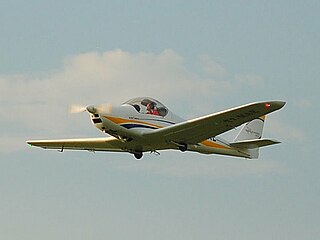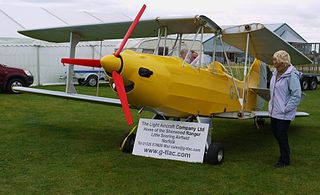
The Kappa 77 KP-2U Sova, later produced as the Jihlavan KP-2U Skyleader and most recently as the Jihlavan Skyleader, is a two-seat civil utility aircraft designed in the Czech Republic and available in kit form for home building. It is a conventional low-wing monoplane featuring all-metal construction and tricycle undercarriage.

The Jabiru 2200 is a lightweight naturally aspirated, pushrod four-stroke, flat four, air-cooled aircraft engine produced by Jabiru Aircraft.

The Scheibe SF-25 Falke is a German touring motor glider developed from the earlier Bergfalke glider by Scheibe Flugzeugbau. Since May 2006 the business has been run by Scheibe Aircraft GmbH.

The MAI-223 Kityonok is a single-engine STOL ultralight aircraft developed by the Moscow Aviation Institute's special design bureau (OSKBEC) from 2002. The first production aircraft was delivered in 2008. A crop spraying version is under development. The aircraft is supplied as a kit for amateur construction or complete and ready-to-fly.

The Coavio DF 2000 is a single-engine, high-wing all-metal ultralight aircraft with side-by-side seating for two. Built in Italy, production began in 2004.

The Breezer is a low-wing, single-engine ultralight aircraft, seating two side by side. Designed and built in Germany, it meets both European and US light-sport aircraft requirements and has been in production since 2001.

The TL Ultralight TL-132 Condor and TL-232 Condor Plus are single engine, highwing ultralight aircraft designed and built in the Czech Republic in the mid-1990s. They remain in production in 2010.

The Roko Aero NG4 is a single-engined sport aircraft, available in both light-sport aircraft and ultralight models, which seats two side by side. It is in production in the Czech Republic.
The S-Wing Swing is a high-wing, two-seat, single-engine ultralight/light sport aircraft designed and built in the Czech Republic.

The Euro-ALA Jet Fox is an Italian single-engine ultralight aircraft, seating two in side-by-side configuration. Production began in the early 1990s, with 280 sold by 2010.

The Groppo XL and Groppo Trail are very similar single engine, tandem seat, high wing ultralight aircraft designed and built in Italy. Both can be supplied complete or in kit form. The two models differ chiefly in undercarriage type.

The Just Escapade is a single-engine, high-wing light aircraft, seating two in side-by-side configuration. It was jointly developed in the United States and the United Kingdom in the early 2000s and by 2010 some 145 Escapades and its "bush plane" variant, the Highlander, had been built and many more kits sold.

The Tiger Cub Developments (TCD) Sherwood Ranger is a single engine, tandem two seat biplane microlight designed and built in the United Kingdom in the early 1990s. Kits were originally produced by TCD; later, design rights were acquired by The Light Aircraft Company Ltd (TLAC) who resumed kit production in 2009.

The Alpi Pioneer 200 is an Italian ultralight and light-sport aircraft, designed and produced by Alpi Aviation, of Pordenone. The aircraft is supplied as a kit for amateur construction or as a complete ready-to-fly-aircraft.

The Aviakit Véga is an ultralight aircraft seating two in side-by-side configuration. It was designed in France in the late 1990s to be easily constructed by amateurs from kits and was offered with a choice of three engines and of tricycle or conventional undercarriages.

The Just SuperSTOL is an American STOL amateur-built aircraft, designed and produced by Just Aircraft of Walhalla, South Carolina. The aircraft is supplied as a kit for amateur construction.

The Gidroplane Tsikada is a light, twin engined utility aircraft, seating two or four in different variants, developed in Russia since about 2000.
The Gidrosamlet Che-24, 26 and 29 are closely related light flying boats designed and built in Russia from 2010.
The Chernov Che-25 is a four-seat, twin engine parasol wing amphibious flying boat built in Russia in the 1990s. The Che-27 is an enlarged, five seat version.
The Marc Parrot, named after the Punta Parrot peak in the Monte Rosa Massif, was specifically designed to fly into unprepared fields and mountain landing strips. The prototype first flew in 2013 but no more had been completed by about 2015.



















